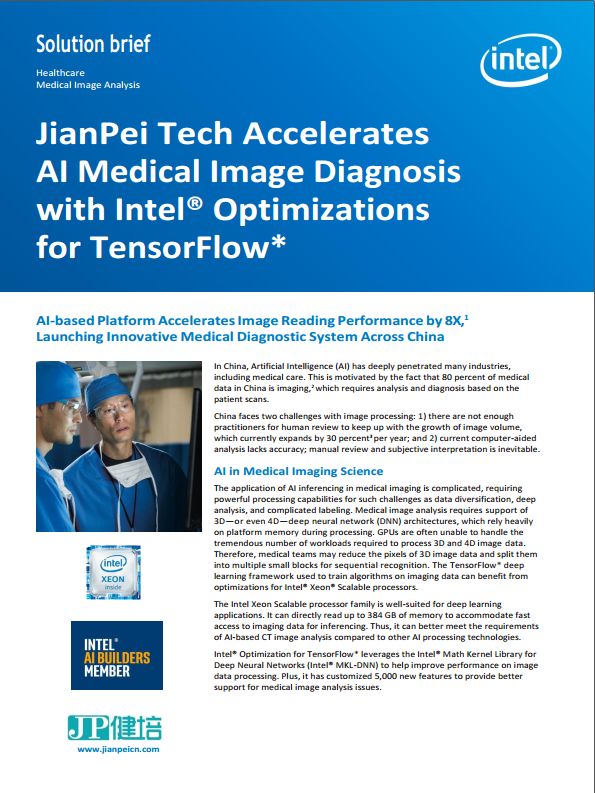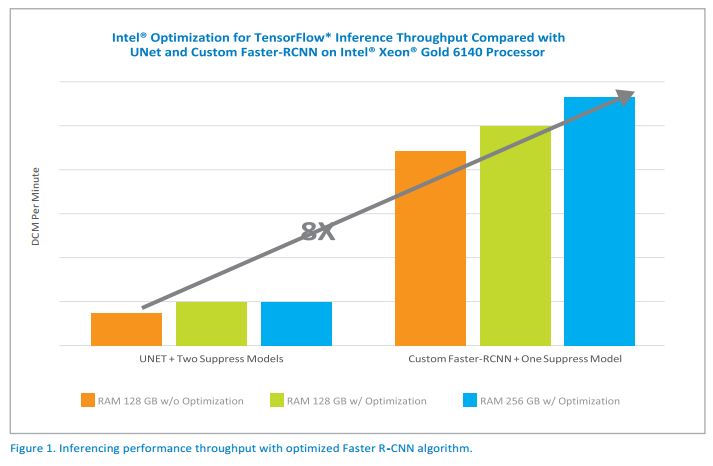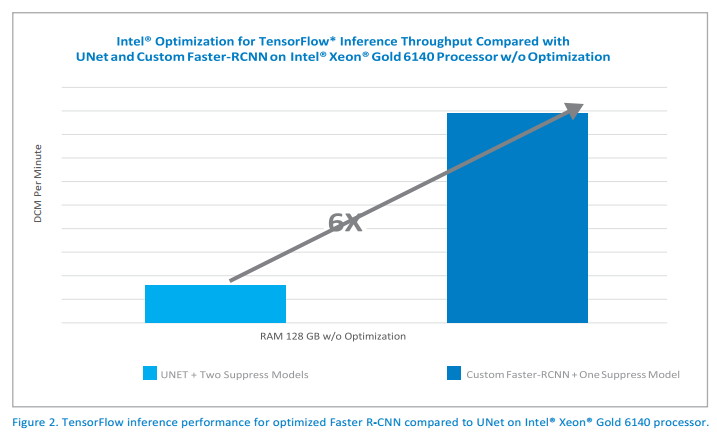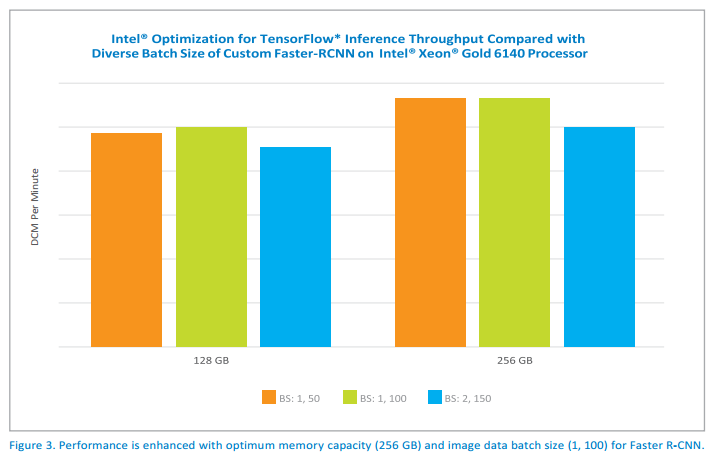英特爾攜手健培科技加快醫學影像人工智能診斷速度
健培科技在醫療影像AI領域持續創造出色的成績,除了自身強大的研發實力之外,還得益于各大合作單位的通力協作。
近日,英特爾官網公布了與健培科技進行技術攻關的成績單,僅基于人工智能平臺的圖像讀取性能上就提升了8倍。

(圖為英特爾官網全球報道)

全文翻譯
In China, Artificial Intelligence (AI) has deeply penetrated many industries, including medical care. This is motivated by the fact that 80 percent of medical data in China is imaging, which requires analysis and diagnosis based on the patient scans.
在中國,人工智能已經深入到包括醫療在內的許多行業。醫療數據中,80%都是影像數據,而影像數據需要根據患者掃描結果進行分析和診斷。
China faces two challenges with image processing: 1) there are not enough practitioners for human review to keep up with the growth of image volume, which currently expands by 30 percent per year; and 2) current computer-aided analysis lacks accuracy; manual review and subjective interpretation is inevitable.
中國在醫療影像處理方面面臨兩大挑戰:1.沒有足夠的從業人員進行人體檢查以滿足圖像量的增長,目前圖像量每年以30%的速度增長;2.目前的計算機輔助分析的準確性尚未獲得驗證;人工審查不可避免。
AI in Medical Imaging Science
醫療影像學人工智能
The application of AI inferencing in medical imaging is complicated, requiring powerful processing capabilities for such challenges as data diversification, deep analysis, and complicated labeling. Medical image analysis requires support of 3D?or even 4D?deep neural network (DNN) architectures, which rely heavily on platform memory during processing. GPUs are often unable to handle the tremendous number of workloads required to process 3D and 4D image data. Therefore, medical teams may reduce the pixels of 3D image data and split them into multiple small blocks for sequential recognition. The TensorFlow* deep learning framework used to train algorithms on imaging data can benefit from optimizations for Intel? Xeon? Scalable processors.
將人工智能應用于醫療影像推理是非常復雜的,需要強大的處理能力來應對數據多樣化、深度學習和復雜標記等挑戰。醫療影像分析需要支持3D甚至4D深度神經網絡(DNN)體系結構,在處理過程中嚴重依賴于平臺內存。GPU通常無法滿足處理3D和4D影像數據時所需的大量工作負載。因此,醫療團隊通常采用減少3D影像數據的像素,并將其分割成多個小的影像塊進行順序識別。用于訓練成像數據算法的TensorFlow*深度學習框架可以從英特爾至強可擴展處理器的優化中獲益。
The Intel Xeon Scalable processor family is well-suited for deep learning applications. It can directly read up to 384 GB of memory to accommodate fast access to imaging data for inferencing. Thus, it can better meet the requirements of AI-based CT image analysis compared to other AI processing technologies.
英特爾可擴展處理器系列非常適合深度學習應用程序。它可以直接讀取高達384GB的內存,以便快速訪問影像數據進行推理。因此,與其他人工智能處理技術相比,它能更好地滿足基于人工智能的CT圖像分析的要求。
Intel? Optimization for TensorFlow* leverages the Intel? Math Kernel Library for Deep Neural Networks (Intel? MKL-DNN) to help improve performance on image data processing. Plus, it has customized 5,000 new features to provide better support for medical image analysis issues.
英特爾TensorFlow*優化利用英特爾深度神經網絡的核心庫(英特爾MKL-DNN)幫助提高影像數據處理性能。此外,它還定制了5000個新功能,以更好地支持醫學圖像分析問題。
Introducing an Image-Reading Robot
介紹一種影像閱片機器人
JianPei Tech LTD’s image analysis robot is built on advanced AI algorithms and deep learning technologies, enabling highly accurate image recognition. Assisting doctors in locating diseases, analyzing conditions, and guiding operations, the image reading robot is part of a clinical decision-making system and is at the frontier of medical science and medical technology development within the country. With the AI-enabled robot, the time needed to complete radiologist diagnoses have reduced immensely. This application has also substantially increased diagnostic accuracy using Intel optimizations.Such impact can advance precision medicine greatly in China.
在中國,人工智能在醫療領域的應用從手術機器人、醫學影像診斷到遠程醫療等細分領域經歷了從無到有,從小到大的跨越式的發展。人工智能對醫療行業不僅僅是顛覆,更多的是創新。健培科技與英特爾合作實際上就是對醫療行業的一次顛覆性創新。在現實應用中,健培閱片機器人的診斷速度、準確率等主要指標均處于行業領先地位。它的出現,除了提高醫生的工作效率外,還將作為輔助診斷,大大提高診斷的效率和準確率。健培閱片機器人可以協助醫生定位疾病、分析病情、指導手術,是臨床決策系統的一部分,處在國內醫學科學和醫學技術發展的前沿地位。
Accelerating AI-Enabled Imaging Analytics and Diagnoses
加速人工智能的圖像分析和診斷
Intel worked with JianPei Tech to optimize their image- reading robot on Intel Xeon Scalable processors for inferencing of X-ray, CT, MRI, and other medical imaging sources. To accelerate image analysis, JianPei Tech’s plat-form was migrated to Intel? Xeon? Gold 6140 processors and optimized with Intel Optimization for TensorFlow, which includes the Intel MKL-DNN library.
英特爾與健培科技合作,優化英特爾至強可擴展處理器上的影像閱片機器人,以推理X射線、CT、MRI和其他醫學成像數據。為了加快圖像分析,健培的平臺被移植到英特爾?至強?金 6140處理器,并使用英特爾? TensorFlow優化庫(包括英特爾? MKL-DNN庫)進行優化。
As shown in Figure 1, the collaborative work resulted in achieving an 8X performance improvement on DICOM (Digital Imaging and Communications in Medicine) images (identified as DCM in Figure 1).1 The speedups were a result of using Faster R-CNN* (Region Convolutional Neural Network) instead of UNet* and optimizing the Faster R-CNN algorithms for Intel Xeon Scalable processors.
如圖1所示,協作工作使DICOM(醫學數字成像和通信)圖像(如圖1所示為DCM)的性能提高了8倍。
英特爾?TensorFlow優化推理吞吐量與英特爾?志強?金 6140處理器上的UNET和自定義Faster R-CNN相比

圖1使用優化的Faster R-CNN算法推理性能吞吐量
Faster R-CNN has also played a role in segmentation analytics in the medical field. Faster R-CNN is well optimized by Intel Optimization for TensorFlow and Intel MKL-DNN, which results in a performance gain of 6X compared to UNet* (see Figure 2).
Faster R-CNN也在醫學領域的細分分析中發揮了作用。Faster R-CNN通過英特爾針對TensorFlow和英特爾MKL-DNN的優化得到了很好的優化,與UNET*相比,其性能提高了6倍(見圖2)。
英特爾?TensorFlow優化推理吞吐量與在英特爾?至強?金6140處理器上自定義Faster R-CNN對比

圖2與英特爾?至強?金 6140處理器上的UNET相比,被TensorFlow優化的Faster R-CNN推理性能優化更快
Optimum memory capacity and image data batch size also enhanced processing performance for faster R-CNN as shown in Figure 3.
最佳的內存容量和圖像數據批量大小也提高了Faster R-CNN的處理性能,如圖3所示。
英特爾?TensorFlow優化推理吞吐量與英特爾?至強?金 6140處理器上不同批量大小的自定義Faster R-CNN相比


微信掃一掃
關注該公眾號